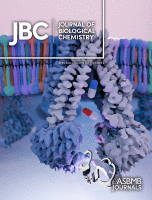- Submit a Protocol
- Receive Our Alerts
- Log in
- /
- Sign up
- My Bio Page
- Edit My Profile
- Change Password
- Log Out
- EN
- EN - English
- CN - 中文
- Protocols
- Articles and Issues
- For Authors
- About
- Become a Reviewer
- EN - English
- CN - 中文
- Home
- Protocols
- Articles and Issues
- For Authors
- About
- Become a Reviewer
An Assay System for Plate-based Detection of Endogenous Peptide:N-glycanase/NGLY1 Activity Using A Fluorescence-based Probe
Published: Vol 15, Iss 1, Jan 5, 2025 DOI: 10.21769/BioProtoc.5151 Views: 1515
Reviewed by: Laxmi Narayan MishraFNU PriyankaAnu ThomasAnonymous reviewer(s)

Protocol Collections
Comprehensive collections of detailed, peer-reviewed protocols focusing on specific topics
Related protocols
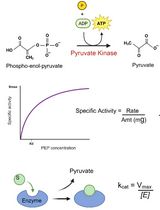
An Optimized Enzyme-Coupled Spectrophotometric Method for Measuring Pyruvate Kinase Kinetics
Saurabh Upadhyay
Aug 20, 2025 2342 Views
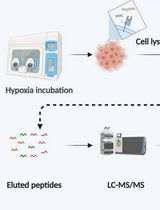
Immunopeptidomics Workflow for Isolation and LC-MS/MS Analysis of MHC Class I-Bound Peptides Under Hypoxic Conditions
Hala Estephan [...] Eleni Adamopoulou
Nov 20, 2025 1715 Views
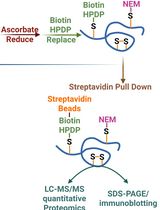
Quantitative Proteomics of Nitrosylated Proteins in Melanoma Using the Biotin-Switch Technique Combined With Tandem Mass Tag Labeling
Vipin K. Yadav [...] Sanjay Premi
Dec 5, 2025 1446 Views
Abstract
Cytosolic peptide: N-glycanase (PNGase/NGLY1 in mammals), an amidase classified under EC:3.5.1.52, is a highly conserved enzyme across eukaryotes that catalyzes the removal of N-glycans from glycoproteins, converting N-glycosylated asparagine residues into aspartic acid. This enzyme also plays a role in the quality control system for nascent glycoproteins. Despite the development of non-radioisotope-based assay systems such as those using S-alkylated RNase or fluorescent-labeled glycopeptides as substrates, these methods are incompatible with crude enzyme sources, primarily due to the degradation of reaction products by contaminating endogenous proteases. We previously developed an assay system using a 5-carboxyfluorescein-labeled glycosylated cyclo-heptapeptide (5FAM-GCP), a substrate remarkably resistant to endogenous peptidase activity. This system enables the accurate measurement of endogenous NGLY1 activity in various samples, including cell lines, tissues, peripheral blood mononuclear cells, and NGLY1-deficient patient-derived cells, without the interference of proteolytic degradation. We recently advanced this approach by producing a novel fluorescence resonance energy transfer (FRET)-based GCP probe (fGCP) and demonstrated its ability to detect endogenous NGLY1 activity across diverse enzyme sources via fluorescence on multiarray plates. This innovative and straightforward assay now offers reliable disease diagnostics and also allows the measurement of endogenous PNGase/NGLY1 activities across various organisms.
Key features
• fGCP assay enables measurement of endogenous PNGase/NGLY1 activity in cells and tissues.
• An aliquot of 1–5 × 106 cells or 50–100 μg of protein extract from tissues is used for this assay.
• This assay enables microplate-based real-time measurement of endogenous PNGase/NGLY1 activities.
• This protocol requires a fluorescence plate reader equipped with an incubation function.
Keywords: Peptide:N-glycanaseGraphical overview
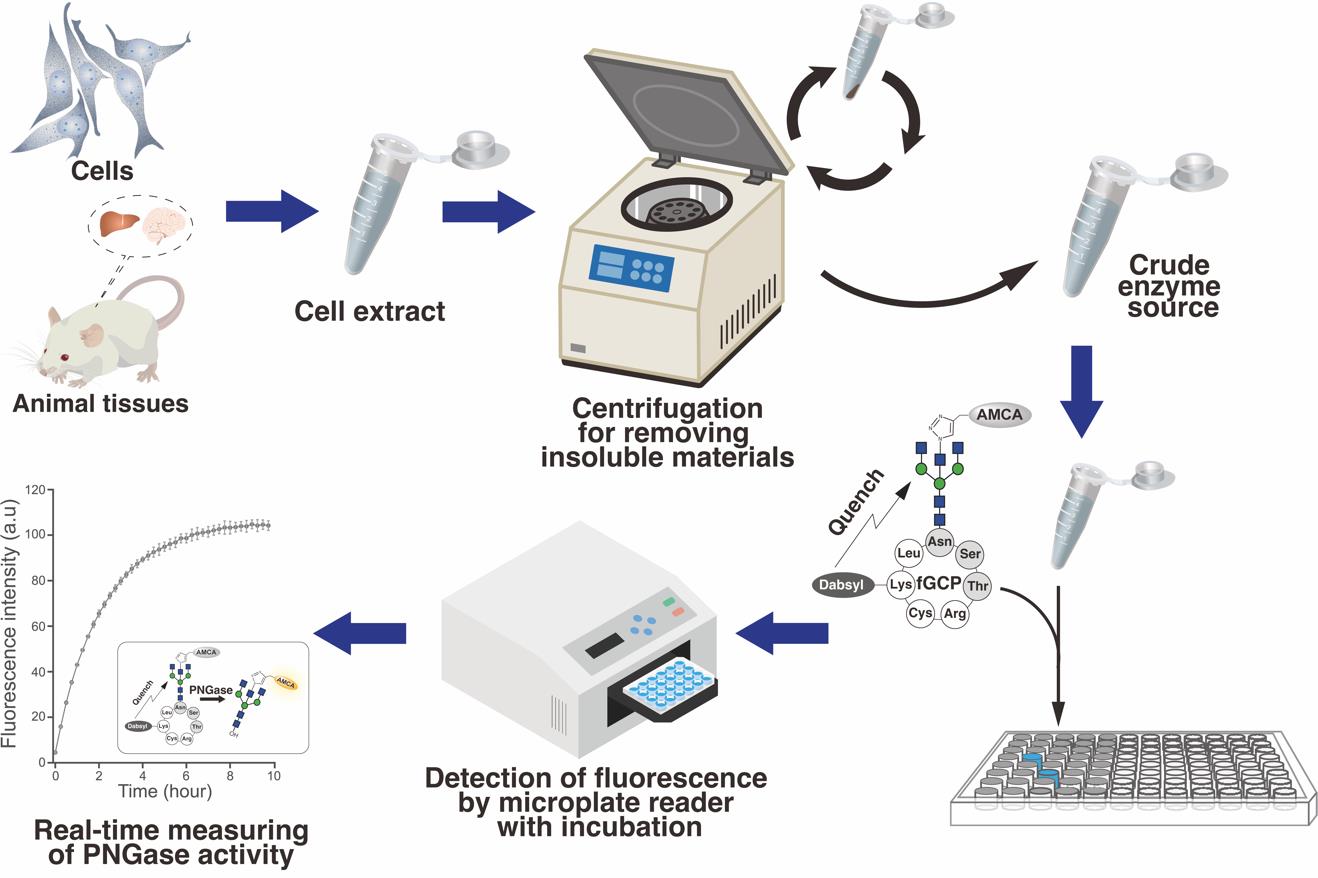
Overview of the real-time measurement of endogenous PNGase/NGLY1 activities in tissues/cells using fGCP assay
Background
Cytosolic peptide: N-glycanase (PNGase; NGLY1 in mammals) is an amidase that catalyzes the removal of N-glycans from the consensus sequences (Asn-Xaa-Ser/Thr, where Xaa represents any amino acid except proline) of glycoproteins, converting N-glycosylated Asn into Asp residues through deglycosylation [1]. Cytosolic PNGase also plays a role in the quality control system for newly synthesized glycoproteins [2].
To explore the biochemical properties of this enzyme, 14C-labeled glycopeptides, such as pentapeptides that carry asialoglycans derived from fetuin, have been commonly used as substrates for measuring PNGase activity [3]. Enzyme activity was measured based on the radioactivity of the reaction products, which were separated by paper chromatography or paper electrophoresis. However, the preparation of radioisotope-labeled glycopeptides and the use of radioactive molecules make it difficult to perform this assay in standard laboratory settings, especially under the tight regulations for the use of radioactive isotopes in Japan. Although non-radioisotope-based assays have been developed (e.g., assays using S-alkylated RNase [4] or fluorescent-labeled glycopeptides [5]), they are incompatible with crude enzyme sources due to the degradation of reaction products by contaminating endogenous proteases. Therefore, there exists a need to develop an alternative, easy-to-handle assay method.
An autosomal recessive disorder linked to NGLY1, known as NGLY1 deficiency or congenital disorder of deglycosylation (NGLY-CDDG) [OMIM: 615273], was first reported in 2012 [6]. Since then, more than 100 patients have been identified worldwide, including in Europe, America, Australia, India, China, and Japan [7,8]. The disease exhibits a broad spectrum of symptoms, including global developmental delay and/or intellectual disability, abnormal EEG, seizures, movement disorders, hypolacrima or alacrima, and liver dysfunction [8–13]. Unfortunately, there are no effective treatments; however, recent studies have demonstrated that administering an adeno-associated viral vector serotype 9 carrying the human NGLY1 gene to Ngly1-deficient model rats aged 3 or 5 to 7 weeks through intracerebroventricular injection significantly improved their motor function defects [14–16]. Considering the importance of the therapeutic time window for gene therapies, early intervention may be crucial to alleviate the various symptoms caused by the dysfunction of the central nervous system in this disease. Therefore, there exists an urgent need for methods to enable the early diagnosis of NGLY1 deficiency by measuring endogenous NGLY1 activity in specimens from potential disease candidates.
A method for measuring endogenous NGLY1 activity using 5-carboxyfluorescein-labeled glycosylated cyclo-heptapeptide (5FAM-GCP) has been established previously [3,17,18]. This approach enables detecting endogenous PNGase/NGLY1 activities from various enzyme sources without the proteolytic degradation of reaction products during incubation with crude enzyme preparations. However, it requires HPLC for the separation and detection of products, which is often unavailable in standard clinical laboratories. Hence, it is crucial to develop a facile, sensitive probe for enzyme assay similar to MM3D, a fluorescence and quencher-based FRET probe designed for detecting ENGase activity [19]. We recently developed a novel FRET-based GCP probe (fGCP) consisting of a glycan modified with a fluorophore-labeled bisected-GlcNAc [aminomethylcoumarin acetate-labeled GlcNAc (AMCA-GlcNAc)] and a cyclo-heptapeptide modified with a quencher, 4-((4-(dimethylamino)phenyl)azo)benzoic acid (Dabcyl) (Figure 1) [20]. This method allows the detection of endogenous NGLY1 activity in various enzyme sources via fluorescence on multiarray plates. Our novel assay method could provide a reliable diagnostic tool and valuable insights into the regulation of PNGase/NGLY1 activities in various organisms.
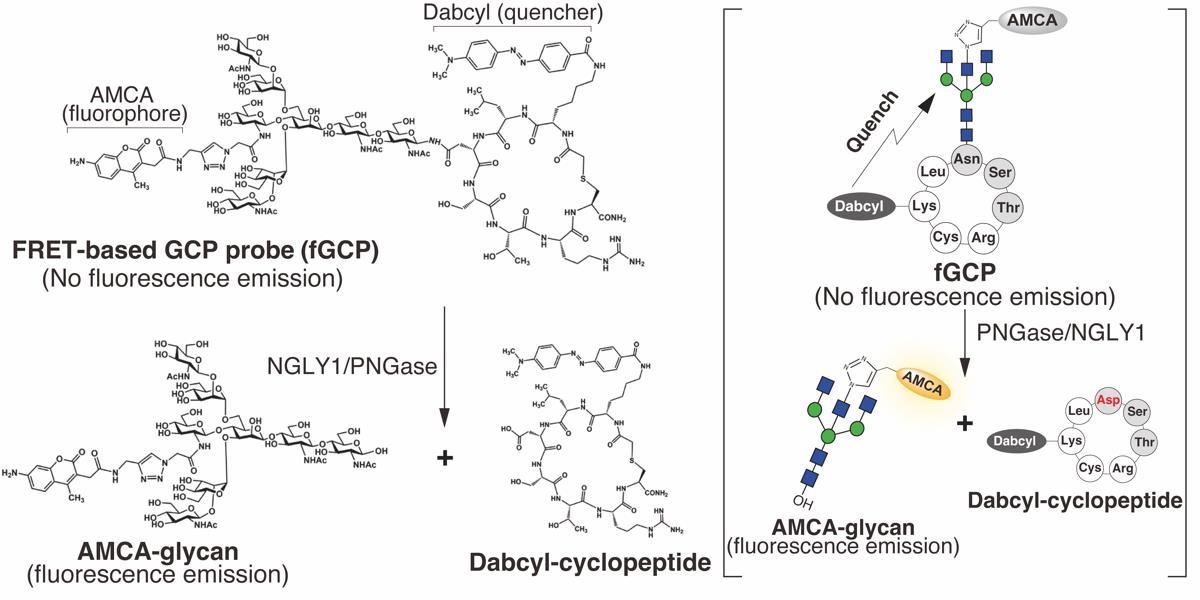
Figure 1. Structure of 5-carboxyfluorescein- and dabcyl-labeled glycosylated cyclo-heptapeptide (fGCP) and deglycosylation reaction catalyzed by PNGase [20]. The bisected-GlcNAc and lysine residues on the glycosylated cyclo-heptapeptide were labeled with a fluorophore, aminomethylcoumarin acetate (AMCA), and a quencher, 4-((4-(dimethylamino)phenyl)azo)benzoic acid (Dabcyl), respectively. The right bracket illustrates a schematic of fGCP and deglycosylation reaction catalyzed by PNGase/NGLY1.
Materials and reagents
Biological materials
1. Rat brain tissues (a rat outbred strain, Sprague-Dawley)
2. Cell lines (e.g., HeLa and HEK293 cells)
3. Fibroblast derived from healthy subjects and NGLY1-deficiency patients (available from Coriell.org)
Reagents
1. 5-Carboxyfluorescein- and dabcyl-labeled glycosylated cyclo-heptapeptide (fGCP, Mw: 2924.9) (GlyTech, Inc.)
2. Sucrose (FUJIFILM Wako Chemicals, catalog number: 196-00015)
3. EDTA (FUJIFILM Wako Chemicals, catalog number: 345-01865)
4. Trizma base (Sigma-Aldrich, catalog number: T1503)
5. NP-40 (IGEPAL® CA-630) (MPBIO, catalog number: 198596)
6. Hydrochloric acid (HCl) (FUJIFILM Wako Chemicals, catalog number: 080-01066)
7. cOmplete EDTA-free protease inhibitor cocktail (Merck-Millipore, catalog number: 11836170001)
8. Pefabloc SC (Merck-Millipore, catalog number: 11429868001)
9. Rabeprazole sodium salt (Tokyo Chemical Industry Co. Ltd., catalog number: R0115)
10. Dithiothreitol (DTT) (FUJIFILM Wako Chemicals, catalog number: M02712)
11. Powermasher II (Nippi-Inc., catalog number: 891-300)
12. Biomasher II (1.5 mL tube) (Nippi-Inc., catalog number: 320-103)
Solutions
1. 10× NGLY1 buffer (see Recipes)
2. Lysis buffer for animal tissues (see Recipes)
3. Lysis buffer for cultured cells (see Recipes)
4. 1 mM fGCP stock solution (see Recipes)
5. 100 μM fGCP working solution (see Recipes)
Recipes
1. 10× NGLY1 buffer
| Reagent | Final concentration | Quantity or Volume |
|---|---|---|
| 1 M Tris-HCl (pH 7.5) | 50 mM | 5 mL |
| Sucrose | 10 mM | 342 mg |
| 500 mM EDTA (pH 8.0) | 5 mM | 1 mL |
| Total | n/a | 100 mL |
Store at room temperature. This buffer remains stable at room temperature for at least one year.
2. Lysis buffer for animal tissues
| Reagent | Final concentration | Quantity or Volume |
|---|---|---|
| 10× NGLY1 buffer | 1× | 100 μL |
| 100 mM DTT | 1 mM | 10 μL |
| 100 mM Pefabloc SC | 1 mM | 10 μL |
| 50× protease inhibitor cocktail | 1× | 20 μL |
| 5 mM Rabeprazole | 50 μM | 10 μL |
| Distilled water | n/a | 850 μL |
| Total | n/a | 1 mL |
40 μL of lysis buffer is used for one reaction. The reagent should be prepared immediately before use.
3. Lysis buffer for cultured cells
| Reagent | Final concentration | Quantity or Volume |
|---|---|---|
| 10× NGLY1 buffer | 1× | 100 μL |
| 10% (v/v) NP-40 | 0.5% (v/v) | 50 μL |
| 100 mM DTT | 1 mM | 10 μL |
| 100 mM Pefabloc SC | 1 mM | 10 μL |
| 50× protease inhibitor cocktail | 1× | 20 μL |
| 5 mM Rabeprazole | 50 μM | 10 μL |
| Distilled water | n/a | 800 μL |
| Total | n/a | 1 mL |
40 μL of the buffer is used for each reaction. The reagent should be prepared immediately before use.
4. 1 mM fGCP stock solution
| Reagent | Final concentration | Quantity or Volume |
|---|---|---|
| fGCP | 1 mM | 1 mg |
| Distilled water | n/a | 342 μL |
Store at -20 °C. This stock remains stable at -20 °C for at least 1–2 years.
5. 100 μM fGCP working solution
| Reagent | Final concentration | Quantity or Volume |
|---|---|---|
| 1 mM fGCP | 100 μM | 1 μL |
| Lysis buffer | n/a | 9 μL |
| Total | n/a | 10 μL |
10 μL of the solution is used for each reaction.
Laboratory supplies
1. 96-well black polystyrene microplate (clear flat bottom) (Corning, catalog number: CLS3603)
Equipment
1. Refrigerated microcentrifuge
2. Sonicator (TOMY, model: UR-21P)
3. Varioskan LUX multimode microplate reader (Thermo, model: VL0000D0)
Procedure
A. Preparation of cell lysate from cultured cells
1. Collect cultured cells (5 × 106 cells) into a tube and wash them with PBS (see Note 1).
2. Resuspend the cells in 50 μL of lysis buffer for cultured cells.
3. Incubate the suspension on ice for 10 min to disrupt the cells.
4. Clarify the samples by centrifugation at 20,000× g for 5 min at 4 °C.
5. Transfer the supernatant to a new tube and use as the enzyme source (see Notes 2 and 3).
B. Preparation of cell lysate from rodent tissues
1. Transfer tissues of interest (e.g., 25–50 mg of the brain) to 1.5 mL Biomasher II tube (see Note 4).
2. Resuspend the tissue into 250 μL of NGLY1 buffer.
3. Lyse the tissue four times by homogenizing for 20 s followed by a cooling period of 20 s on ice using Powermasher II.
4. Clarify the samples by centrifugation at 20,000× g for 5 min at 4 °C.
5. Transfer the supernatant to a new tube and use as the enzyme source (see Note 3).
6. Calculate protein concentration in the cell lysate by protein assay (e.g., BCA assay) (see Note 5).
C. Real-time measurement of PNGase/NGLY1 activity
1. Transfer 40 μL of the enzyme source to a 96-well black polystyrene microplate (see Note 6).
2. Add 10 μL of 100 μM fGCP solution to the well loaded with the enzyme source and mix the solution by pipetting.
3. Immediately set the plate on the Varioskan LUX multimode microplate reader (see Note 7).
4. Measure fluorescence intensity every 15 min with incubation at 25 °C for 6–12 h (λ excitation: 353 nm; λ emission: 450 nm) (Figure 2A and C, Figure 3A and C) (see Notes 8 and 9).
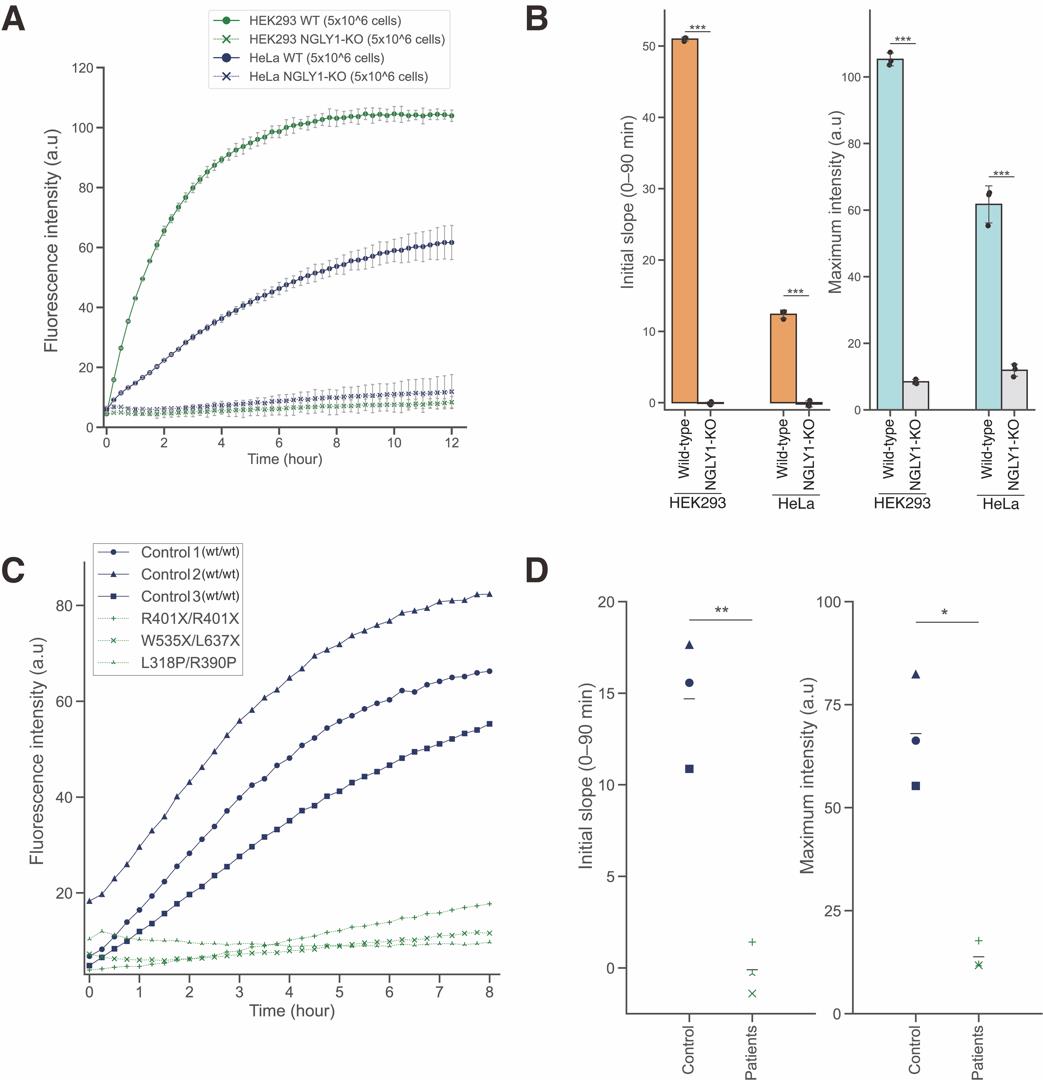
Figure 2. Real-time measurement of NGLY1 activity in cultured cell lines and evaluation of the endogenous NGLY1 activity in patients’ fibroblast using fGCP assay [20]. A. Analysis of endogenous NGLY1 activity in HeLa and HEK293 cells. NGLY1-KO cells show no endogenous NGLY1 activity in both cell lines. Each cell extract prepared from 5 × 106 cells was incubated with fGCP for 12 h at 25 °C. The fluorescence intensity of fGCP was measured every 15 min. B. Two parameters, initial slope (0–90 min) and maximum fluorescence intensity of endogenous NGLY1 activity were measured in HeLa and HEK293 cells. C. Real-time measurement of endogenous NGLY1 activity (measured every 15 min) in fibroblasts. The fluorescence intensity of each sample was measured by incubating fGCP with crude cell extract prepared from 5 × 106 cells for 8 h at 25 °C. D. Quantitative analysis of endogenous NGLY1 activity in fibroblasts. The horizontal line represents the means of biological triplicates for control- or patient-derived samples. Error bars are mean ± S.D. from biological triplicates. For statistical analysis, a Student’s t-test was applied. *, **, and *** represent p < 0.05, p < 0.01, and p < 0.001, respectively.

Figure 3. Real-time measurement of NGLY1 activity in rat tissues: liver and brain [20]. A. Real-time measurement of endogenous Ngly1 activity (measured every 15 min) in rat liver of various ages. The fluorescence intensity of each sample was measured by incubating fGCP with 116 μg of protein extract from the liver for 12 h at 25 °C. B. Quantitative analysis of (A). C. Real-time measurement of endogenous Ngly1 activity (measured every 15 min) in rat brain. Fluorescence intensity of each sample was measured by incubating fGCP with 116 μg of protein extract from the brain for 12 h at 25 °C. D. Quantitative analysis of C. Error bars are means ± S.D. (n = 3 rats in each age). For statistical analysis, a Student’s t-test was applied. *, **, and *** represent p < 0.05, p < 0.01, and p < 0.001, respectively.
Data analysis
1. For calculating the fluorescence intensity in each sample, the blank value should be subtracted from all other sample values.
2. Fluorescence intensity should be normalized by cell number or protein concentration.
3. Reaction curves can be evaluated using the initial slope (slope of 0–90 min) and the maximum intensity of the reaction (Figure 2B and D, Figure 3B and D) (see Notes 10 and 11).
Validation of protocol
This protocol has been used and validated in the following research article:
• Hirayama et al. [20]. Development of a fluorescence and quencher-based FRET assay for detection of endogenous peptide: N-glycanase/NGLY1 activity. J Biol Chem 300(4): 107121 (Figures 4–6).]
General notes and troubleshooting
General notes
1. The collected cells can be flash frozen in liquid nitrogen and stored at -80 °C until use.
2. For one assay, 1–5 × 106 cells were required to prepare the crude extract.
3. Cells or tissue lysates should be prepared immediately before the assay, as NGLY1 activity is drastically decreased in frozen crude lysates.
4. The preserved frozen tissues (stored at -80 °C) are also used as a source of the enzyme in this assay.
5. Lysates containing 50–100 μg of proteins are required for one assay.
6. Prepare a blank well containing 40 μL of the same buffer as samples (lysis buffer for animal tissues or cultured cells) and 10 μL of 100 μM fGCP working solution.
7. Keep the lid of the assay plate closed to prevent evaporation of the solution.
8. For the evaluation of endogenous NGLY1 activity, it is preferable to perform assays of the lysates prepared from NGLY1-KO cells or lysates treated with 100 μM of zVAD-fmk, a potent NGLY1-inhibitor [21], as a negative control.
9. Replicate experiments (biological or technical) should be carried out to ensure accurate interpretation of the results through statistical analysis.
10. It is possible to determine the initial slope by measuring two time points (0 and 90 min) to compare the relative enzyme activity among the samples. However, real-time measuring of the reaction for 8–12 h is preferable to obtain more information on the enzyme properties (e.g., background level, maximum activity, and time to reach plateau)
11. To calculate the specific activity of NGLY1 (expressed as pmol of deglycosylated fGCP per minute normalized by protein concentration; pmol/min/mg protein), create a standard curve of the concentration of fGCP treated with PNGase F and the fluorescence intensity. Then, calculate the pmol of the product (i.e., deglycosylated substrate) from the standard curve. Alternatively, the 5FAM-GCP assay [18], which can measure enzyme activity through the separation of the substrate and product using HPLC, can also be used.
Troubleshooting
Problem 1: Fluorescence signal is low throughout the experiment.
Possible cause: Number of cells/total tissues for the preparation of cell lysates is too low.
Solution(s): Prepare more cells/tissues.
Acknowledgments
Research reported in this publication was supported by the T-CiRA Program (NGLY1 Deficiency Project), the RIKEN Pioneering Project (“Glyco-lipidologue Initiative”), Japan Agency for Medical Research and Development Core Research for Evolutional Science and Technology (AMED-CREST) Grant JP24gm14100003h0005 (to T.S.), and by KAKENHI Grant Number JP22K06155 (to H.H.) from the Ministry of Education, Culture, Sports, Science, and Technology (MEXT)/Japan Society for the Promotion of Science (JSPS). The image of cells in the Graphical overview was provided by DBCLS Togo Picture Gallery (2016 DBCLS TogoTV; https://togotv.dbcls.jp/pics.html). We thank Enago (https://www.enago.jp) for the English language review. This protocol was adapted and modified from Hirayama et al. [20].
Competing interests
The authors declare that they have no competing interests.
Ethical considerations
Care procedures and experiments of a rat outbred strain, Sprague–Dawley, conformed to the association for assessment and accreditation of laboratory animal care guidelines. All experiments using animals were approved by the experimental animal care and use committee of our organization.
References
- Suzuki, T., Park, H. and Lennarz, W. J. (2002). Cytoplasmic peptide:N-glycanase (PNGase) in eukaryotic cells: occurrence, primary structure, and potential functions. FASEB J. 16(7): 635–641.
- Hirayama, H., Hosomi, A. and Suzuki, T. (2015). Physiological and molecular functions of the cytosolic peptide:N-glycanase. Semin Cell Dev Biol. 41: 110–120.
- Hirayama, H. and Suzuki, T. (2022). Assay for the peptide:N-glycanase/NGLY1 and disease-specific biomarkers for diagnosing NGLY1 deficiency. J Biochem. 171(2): 169–176.
- Suzuki, T. (2005). A simple, sensitive in vitro assay for cytoplasmic deglycosylation by peptide: N-glycanase. Methods. 35(4): 360–365.
- Taga, E. M., Waheed, A. and Van Etten, R. L. (1984). Structural and chemical characterization of a homogeneous peptide N-glycosidase from almond. Biochemistry. 23(5): 815–822.
- Need, A. C., Shashi, V., Hitomi, Y., Schoch, K., Shianna, K. V., McDonald, M. T., Meisler, M. H. and Goldstein, D. B. (2012). Clinical application of exome sequencing in undiagnosed genetic conditions. J Med Genet. 49(6): 353–361.
- Pandey, A., Adams, J. M., Han, S. Y. and Jafar-Nejad, H. (2022). NGLY1 Deficiency, a Congenital Disorder of Deglycosylation: From Disease Gene Function to Pathophysiology. Cells. 11(7): 1155.
- Abuduxikuer, K., Zou, L., Wang, L., Chen, L. and Wang, J. S. (2020). Novel NGLY1 gene variants in Chinese children with global developmental delay, microcephaly, hypotonia, hypertransaminasemia, alacrimia, and feeding difficulty. J Hum Genet. 65(4): 387–396.
- Enns, G. M., Shashi, V., Bainbridge, M., Gambello, M. J., Zahir, F. R., Bast, T., Crimian, R., Schoch, K., Platt, J., Cox, R., et al. (2014). Mutations in NGLY1 cause an inherited disorder of the endoplasmic reticulum-associated degradation pathway. Genet Med. 16(10): 751–758.
- Ge, H., Wu, Q., Lu, H., Huang, Y., Zhou, T., Tan, D. and ZhongqinJin (2020). Two novel compound heterozygous mutations in NGLY1 as a cause of congenital disorder of deglycosylation: a case presentation. BMC Med Genet. 21(1): 135.
- Lam, C., Ferreira, C., Krasnewich, D., Toro, C., Latham, L., Zein, W. M., Lehky, T., Brewer, C., Baker, E. H., Thurm, A., et al. (2017). Prospective phenotyping of NGLY1-CDDG, the first congenital disorder of deglycosylation. Genet Med. 19(2): 160–168.
- Lipari Pinto, P., Machado, C., Janeiro, P., Dupont, J., Quintas, S., Sousa, A. B. and Gaspar, A. (2020). NGLY1 deficiency-A rare congenital disorder of deglycosylation. JIMD Rep. 53(1): 2–9.
- Sonoda, Y., Fujita, A., Torio, M., Mukaino, T., Sakata, A., Matsukura, M., Yonemoto, K., Hatae, K., Ichimiya, Y., Chong, P. F., et al. (2024). Progressive myoclonic epilepsy as an expanding phenotype of NGLY1-associated congenital deglycosylation disorder: A case report and review of the literature. Eur J Med Genet. 67: 104895.
- Asahina, M., Fujinawa, R., Hirayama, H., Tozawa, R., Kajii, Y. and Suzuki, T. (2021). Reversibility of motor dysfunction in the rat model of NGLY1 deficiency. Molecular Brain. 14(1): 91.
- Fujihira, H., Asahina, M. and Suzuki, T. (2022). Physiological importance of NGLY1, as revealed by rodent model analyses. J Biochem. 171(2): 161–167.
- Zhu, L., Tan, B., Dwight, S. S., Beahm, B., Wilsey, M., Crawford, B. E., Schweighardt, B., Cook, J. W., Wechsler, T. and Mueller, W. F. (2022). AAV9-NGLY1 gene replacement therapy improves phenotypic and biomarker endpoints in a rat model of NGLY1 Deficiency. Mol Ther Methods Clin Dev. 27: 259–271.
- Hirayama, H., Tachida, Y., Seino, J. and Suzuki, T. (2022). A method for assaying peptide: N-glycanase/N-glycanase 1 activities in crude extracts using an N-glycosylated cyclopeptide. Glycobiology. 32(2): 110–122.
- Hirayama, H. and Suzuki, T. (2022). Enzyme assay of endogenous activity of peptide-N-glycanase (PNGase)/N-Glycanase 1 (NGLY1) in cells and tissues using glycosylated cyclopeptide as a substrate. In: Nishihara, S., Angata, K., Aoki-Kinoshita, K. F. and Hirabayashi, J. (Eds.) Glycoscience Protocols (GlycoPODv2).
- Ishii, N., Muto, H., Nagata, M., Sano, K., Sato, I., Iino, K., Matsuzaki, Y., Katoh, T., Yamamoto, K. and Matsuo, I. (2023). A fluorogenic probe for core-fucosylated glycan-preferred ENGase. Carbohydr Res. 523: 108724.
- Hirayama, H., Tachida, Y., Fujinawa, R., Matsuda, Y., Murase, T., Nishiuchi, Y. and Suzuki, T. (2024). Development of a fluorescence and quencher-based FRET assay for detection of endogenous peptide:N-glycanase/NGLY1 activity. J Biol Chem. 300(4): 107121.
- Misaghi, S., Pacold, M. E., Blom, D., Ploegh, H. L. and Korbel, G. A. (2004). Using a small molecule inhibitor of peptide: N-glycanase to probe its role in glycoprotein turnover. Chem Biol. 11(12): 1677–1687.
Article Information
Publication history
Received: Aug 25, 2024
Accepted: Nov 6, 2024
Available online: Nov 20, 2024
Published: Jan 5, 2025
Copyright
© 2025 The Author(s); This is an open access article under the CC BY-NC license (https://creativecommons.org/licenses/by-nc/4.0/).
How to cite
Readers should cite both the Bio-protocol article and the original research article where this protocol was used:
- Hirayama, H. and Suzuki, T. (2025). An Assay System for Plate-based Detection of Endogenous Peptide:N-glycanase/NGLY1 Activity Using A Fluorescence-based Probe. Bio-protocol 15(1): e5151. DOI: 10.21769/BioProtoc.5151.
Hirayama, H., Tachida, Y., Fujinawa, R., Matsuda, Y., Murase, T., Nishiuchi, Y. and Suzuki, T. (2024). Development of a fluorescence and quencher-based FRET assay for detection of endogenous peptide:N-glycanase/NGLY1 activity.J Biol Chem. 300(4): 107121.
Category
Biochemistry > Protein > Fluorescence
Biochemistry > Protein > Quantification
Do you have any questions about this protocol?
Post your question to gather feedback from the community. We will also invite the authors of this article to respond.
Share
Bluesky
X
Copy link


